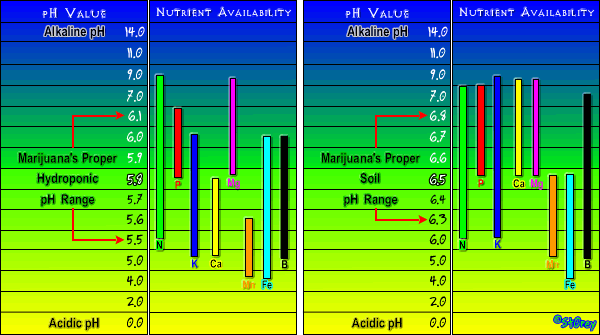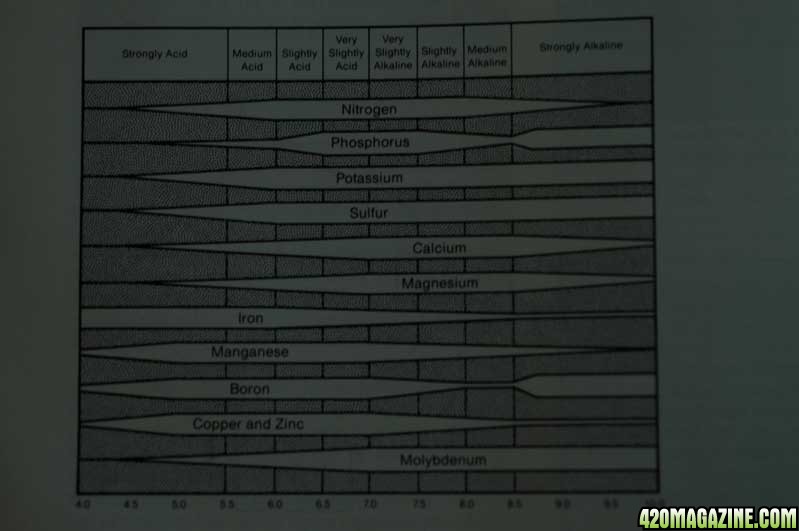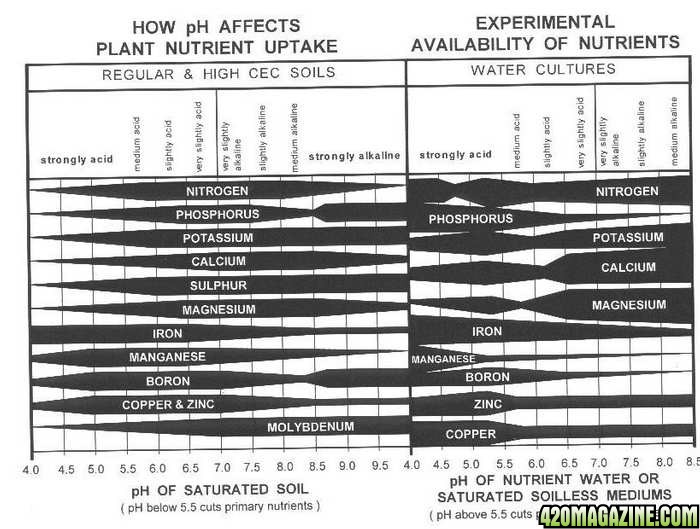Navigation
Install the app
How to install the app on iOS
How To Use Progressive Web App aka PWA On 420 Magazine Forum
Note: This feature may not be available in some browsers.
More options
You are using an out of date browser. It may not display this or other websites correctly.
You should upgrade or use an alternative browser.
You should upgrade or use an alternative browser.
PH and Nutrient Uptake charts!
- Thread starter ledtester
- Start date
great find..
- Thread starter
- #3
great find..
Thanks PV...here's some more.
The lesson here is to help you measure and understand the readings you obtain from pH and EC meters...
Let me first explain what pH & EC mean, and what effects them...
pH stands for Potential Hydrogen and is a measure of the concentration of hydrogen ions within a solution like water. pH is measured on a scale of 0 to 14 with 0 being acid, 7 is neutral and 14 is alkaline. A substance that when added to water increases the hydrogen ion concentration will cause the pH level to drop. This is known as a acid. A substance that reduces the concentration on hydrogen ions and causes the pH to rise is known a base. There are also some substances that can enable the solution to resist pH changes when an acid or base is added. These are known as buffers. Buffers are very important in helping organisms maintain a relatively constant pH and they are also used to calibrate your pH meter occasionally.
If the pH of your nutrient solution is too high (alkaline) or too low (acidic), it can restrict the uptake of nutrients through the roots of your plants. Many different variables such as evaporation, amount of light and temperature can affect pH levels. Most plants can accept a pH range of between 5 and 7. Any extremes either side of that range will cause the plants to be blocked from certain nutrients. In low light, plants take up more potassium and phosphorus from the nutrient solution so the acidity increases (pH drops). In strong intense light, plants take up more nitrogen from the solution so the acidity decreases (pH rises). Any extremes of pH can also result in precipitation of certain blocked nutrients.
For plant roots to be able to absorb nutrients, the nutrients must be dissolved in a solution. The process of precipitation (the reverse of dissolving) results in the formation of solids in the nutrient solution, making the nutrients unavailable to the plants. Precipitation can also take the form of an almost invisible film of an oily look on the surface of your water.
EC stands for Electrical Conductivity and is a measure of the strength of the nutrient solution. The higher the conductivity, the more dissolved solids there are in the solution. EC is just one format of measuring the nutrients. It can also be measured in PPM (Parts Per Million), and TDS (Total Dissolved Solids). EC is the standard these days and is used in Canada, Europe, and most other places...
Plants at different stages of growth need different amounts of food in their solution. Delicate plants like cuttings and seedlings requre the EC to be quite low so as to avoid fertilizer burn from over-feeding. As the plant gets older the food concentration can be increased (EC raised) so the plants have access to more nutrients in the water. Low conductivity at this point or low strength nutrient solutions will result in nutritional deficiencies and slow growth rates of your plants. EC can be affected by many variables too. Evaporation, temperature and ventilation are all factors that affect the EC level in your solution aswell...
bigdeal422
New Member
Great info man. Thanks for posting this as now it's so much easier to reference than looking this stuff up on the internet. +rep for putting it all into perspective.
Can I buy EC meters at local hardware shops? if not where can I get them without using internet.
- Thread starter
- #6
Can I buy EC meters at local hardware shops? if not where can I get them without using internet.
other then a hydro store, try places that sell plants, nurseries, home depot, they're more likely to carry them.
wtfruthinking
New Member
LED- Wondering if you know what the reason may be for ph levels to rise instead of fall. I tested for chlorine and measured my ph for the flowers and it was set at 6.3 (flushed with new water) Next day it was 8.0. I used 2 different ph meters and 2 different manual PH Test Indicator methods...all confirming that it was extremely high.
Same thing happened in the veg room. I freaked out and checked my cloning bucket and it rose from 5.8 to 7.0.
I'm totally at a lost. Any idea?

Same thing happened in the veg room. I freaked out and checked my cloning bucket and it rose from 5.8 to 7.0.
I'm totally at a lost. Any idea?

LED- Wondering if you know what the reason may be for ph levels to rise instead of fall. I tested for chlorine and measured my ph for the flowers and it was set at 6.3 (flushed with new water) Next day it was 8.0. I used 2 different ph meters and 2 different manual PH Test Indicator methods...all confirming that it was extremely high.
Same thing happened in the veg room. I freaked out and checked my cloning bucket and it rose from 5.8 to 7.0.
I'm totally at a lost. Any idea?
Nutes will take it up of course, I presume you are adding nutes or have time release soil that releases nutes?
wtfruthinking
New Member
Nutes will take it up of course, I presume you are adding nutes or have time release soil that releases nutes?
OOps// didn't realize this was was "soil" ..I'm growing hydro and flushing with plain water and only water. Any idea what could be causing it to increase like that?
- Thread starter
- #12
LED- Wondering if you know what the reason may be for ph levels to rise instead of fall. I tested for chlorine and measured my ph for the flowers and it was set at 6.3 (flushed with new water) Next day it was 8.0. I used 2 different ph meters and 2 different manual PH Test Indicator methods...all confirming that it was extremely high.
Same thing happened in the veg room. I freaked out and checked my cloning bucket and it rose from 5.8 to 7.0.
I'm totally at a lost. Any idea?

temperature changes ph quite a bit also the bigger the rez of water the more stable it is...nutes tend to lower the ph slightly and should be added first...water in a bucket will change rapidly as the temp changes..to help them a bit place styrofoam insulation under them or work out a circulating system...hydro is best with water between 67-70 if possible...try to do the water a head of time and it will stabilize better....always takes a good half to a day to stabilize a big 50 gal rez but it will last close to a week
wtfruthinking
New Member
well excuse me for trying to be helpful. have fun
I'm sorry Lions... Did not mean to offend you in any way. As I was about to respond I noticed that I had posted the question in the "Indoor Soil" section and didn't want to waste anyone's time since I was in the wrong section.
 Thank you for your input..It is much appreciated. Again..I wasn't trying to be rude.
Thank you for your input..It is much appreciated. Again..I wasn't trying to be rude.wtfruthinking
New Member
temperature changes ph quite a bit also the bigger the rez of water the more stable it is...nutes tend to lower the ph slightly and should be added first...water in a bucket will change rapidly as the temp changes..to help them a bit place styrofoam insulation under them or work out a circulating system...hydro is best with water between 67-70 if possible...try to do the water a head of time and it will stabilize better....always takes a good half to a day to stabilize a big 50 gal rez but it will last close to a week
LED- I'm going to check the temperature and see where it's at.. I didn't realize temperature could make that big of a difference. Thanks for the input.. Hope that solves the problem.. I'll let you know.

Please also consider that nutrients act as a buffer, meaning that pH will change less radically the more nutes that are present.
So if you are flushing with plain water (without buffer) changes can be more extreme.
When in the sweet spot of a hydro nute regime it might take 10 to 15 drops of pH up or down to move the pH 0.5. in plain water this amount could move it 10 times as much.
Plants take what they need, it's not unusual (in hydro) at a certain phase to be adjusting down, then in another phase, a few weeks later, to be adjusting up.
Key thing to remember - don't adjust both ways in the same solution
Best wishes to you
So if you are flushing with plain water (without buffer) changes can be more extreme.
When in the sweet spot of a hydro nute regime it might take 10 to 15 drops of pH up or down to move the pH 0.5. in plain water this amount could move it 10 times as much.
Plants take what they need, it's not unusual (in hydro) at a certain phase to be adjusting down, then in another phase, a few weeks later, to be adjusting up.
Key thing to remember - don't adjust both ways in the same solution

Best wishes to you
wtfruthinking
New Member
Please also consider that nutrients act as a buffer, meaning that pH will change less radically the more nutes that are present.
So if you are flushing with plain water (without buffer) changes can be more extreme.
When in the sweet spot of a hydro nute regime it might take 10 to 15 drops of pH up or down to move the pH 0.5. in plain water this amount could move it 10 times as much.
Plants take what they need, it's not unusual (in hydro) at a certain phase to be adjusting down, then in another phase, a few weeks later, to be adjusting up.
Key thing to remember - don't adjust both ways in the same solution
Best wishes to you
So if I added too much ph up..I shouldn't use ph down? I didn't know that. Did I understand that correctly?
Correct, you don't want to use up and down in the same reservoir.
If you overshoot, you should change your res out
It's better to do your adjustment in your makeup water.
For example if you've got a 5 gallon rez and you know 1- drops will bring you where you want to be. Add these 10 drops to you make up water - then add the make up water to your reservoir.
This way of you get too many drops in - it's not in your res, you can just dump the make up and do it over.
If you add the make up and it doesn't come out where you want it, you can always remove some of the res water and adjust to it then put it back in.
If you overshoot, you should change your res out
It's better to do your adjustment in your makeup water.
For example if you've got a 5 gallon rez and you know 1- drops will bring you where you want to be. Add these 10 drops to you make up water - then add the make up water to your reservoir.
This way of you get too many drops in - it's not in your res, you can just dump the make up and do it over.
If you add the make up and it doesn't come out where you want it, you can always remove some of the res water and adjust to it then put it back in.
wtfruthinking
New Member
I'm using GH nutes. However I recently found out the instructions on the back of the bottle (using as a general guide) was causing me to overfeed. My temp in my reservoir was 61 degrees. I recently purchased a heater and the ph seems to even out. Very good tip to know about not mixing the 2 if I overshoot. Thanks guys. 

What kind of set up do you have where your reservoir is too cold?
Normally Hydro people would die to have their res naturally cold
The plants in the sam room with light and res so either the room is too cold or ??
The reason I mention this is that colder water hold much higher oxygen content than warmer water, so a cold reservoir is desirable.
Normally Hydro people would die to have their res naturally cold

The plants in the sam room with light and res so either the room is too cold or ??
The reason I mention this is that colder water hold much higher oxygen content than warmer water, so a cold reservoir is desirable.
Saturn
New Member
What about when you're trying to adjust water ph to soil ph.
If soil is 7.0, would you use 6.0 water to try and achieve 6.5?
If soil is 7.0, would you use 6.0 water to try and achieve 6.5?
Similar threads
- Replies
- 11
- Views
- 1K
- Replies
- 11
- Views
- 8K
- Replies
- 0
- Views
- 7K
- Replies
- 23
- Views
- 21K






